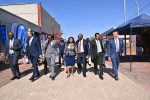By Monica Nangutuwala
In an effort to extend telecommunications access to underserved communities, the Communications Regulatory Authority of Namibia (CRAN), through its Universal Service Fund (USF), concluded a comprehensive site verification exercise across nine (9) regions. Conducted from 28 April to 23 May 2025, the exercise focused on assessing 16 proposed sites for the upcoming Phase two (2) of the USF rollout, with the goal of expanding mobile broadband and voice services to underserved and unserved communities.
The verification process targeted 25 institutions, comprising 23 schools and two (2) clinics, in the ǃKaras, Kunene, Omaheke, Otjozondjupa, Omusati, Ohangwena, Oshikoto, Kavango East, and Zambezi Regions. The purpose was to evaluate existing telecommunications infrastructure, identify gaps, and determine the quality and availability of internet and voice services in these communities.
Key Findings Highlight Urgent Connectivity Gaps
The results reveal a picture of little or no connectivity in these areas. Of the 23 schools visited, 14 have no network connectivity at all, while nine (9) experience intermittent service. Both clinics were found to have no voice or data connectivity.
While some institutions are connected via existing infrastructure, the service provided is either through Very Small Aperture Terminal (VSAT) satellite links or Point-to-Point (P2P) connections leading to very slow broadband and unreliable service.
Methodology and Field Assessment
CRAN’s team employed a rigorous methodology during the verification exercise. Site visits involved detailed planning using Global Positioning System (GPS) applications, prior coordination with school and clinic administrators, and on-the-ground assessments. During visits, the team tested network performance, conducted speed tests, and documented all challenges.
Implications and Next Steps
The findings emphasise the critical need for constructing and upgrading telecommunications infrastructure in these regions. The USF will leverage these insights to identify suitable sites for new infrastructure deployment. The plan involves providing subsidies to licensed telecommunications providers (mobile network operators) to deploy infrastructure for mobile broadband and voice services, thereby bridging the digital gap.
Furthermore, most institutions are connected to the electricity grid, with a few relying on solar power, and all are housed in brick structures except for one (1) made of corrugated iron sheets. These infrastructural details will inform deployment strategies, ensuring the solutions are sustainable and resilient.
The lack of connectivity not only hampers educational and health outcomes but also stifles economic opportunities in these communities. Upgrading and expanding network infrastructure will increase and improve access to internet connectivity – fostering inclusive growth, empowering local populations, and supporting Namibia’s broader digital transformation goals.
As Namibia advances into Phase two (2) of the USF rollout, the insights gained from this verification exercise will be instrumental in shaping targeted interventions. The goal remains clear: to ensure that no community is left behind in the digital age, and that mobile broadband and voice services reach even the most remote corners of the country.
Monica Nangutuwala is an Analyst: Universal Access & GIS at Communications Regulatory Authority of Namibia (CRAN)










